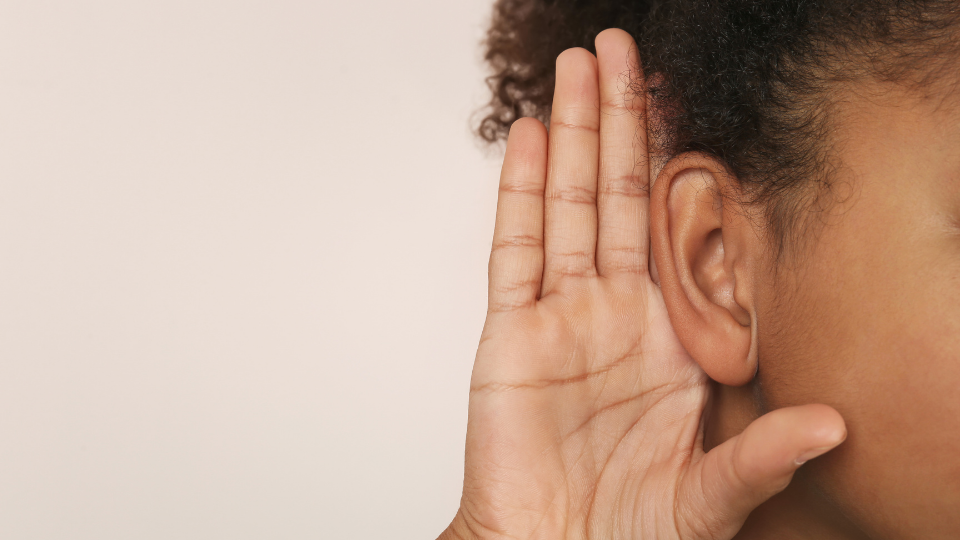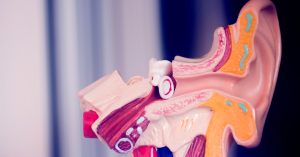Not being able to hear out of your right ear can feel unsettling and frustrating—especially when it seems to come out of nowhere. Whether it’s a gradual change or a sudden shift, right-ear hearing loss is a signal that something in your auditory system isn’t working as it should. And while the causes can range from something as simple as a wax blockage to more serious inner ear or nerve issues, one thing is clear: ignoring it isn’t the answer.
One-sided hearing loss, also called unilateral hearing loss, can affect your ability to understand speech, localize sounds, and stay balanced. In some cases, it can even hint at an underlying medical condition that needs attention. That’s why understanding what’s going on—and knowing when to seek help—is so important.
In this article, we’ll walk you through the possible causes of right-ear hearing loss, the symptoms to watch for, how doctors diagnose the problem, and what treatments may be available. We’ll also share tips on protecting your hearing so you can maintain better ear health in the future.
What Causes Hearing Loss in One Ear?
When you experience hearing loss in just your right ear, it’s natural to wonder why only one side is affected. The truth is, several conditions can impact one ear without affecting the other, depending on how and where the issue occurs in your hearing system. Let’s explore the most common reasons for right-ear hearing loss.
1. Impacted Earwax
A wax blockage is one of the simplest and most common causes of one-sided hearing loss. If earwax becomes compacted in your right ear, it can prevent sound waves from reaching the eardrum, resulting in a sensation of muffled or reduced hearing. This is especially likely if you’ve used cotton swabs or earplugs frequently.
2. Middle or Outer Ear Infections
Ear infections can cause inflammation and fluid buildup in one ear, leading to temporary hearing loss. You may notice pain, a feeling of fullness, or drainage. Middle ear infections (otitis media) are more common in children but can affect adults, while outer ear infections (otitis externa or “swimmer’s ear”) often follow water exposure.
3. Eustachian Tube Dysfunction
The Eustachian tube connects the middle ear to the back of the throat and helps equalize pressure. When it’s blocked due to allergies, sinus infections, or colds, it can lead to temporary hearing loss in one ear, often with a feeling of fullness or pressure. This condition is usually temporary but can linger in some cases.
4. Sudden Sensorineural Hearing Loss (SSHL)
SSHL is a sudden, unexplained loss of hearing in one ear—typically occurring within hours or days. It’s considered a medical emergency and often affects only one side, like the right ear. SSHL is thought to result from viral infections, inflammation, or circulation problems in the inner ear. Prompt treatment with corticosteroids gives the best chance of recovery.
5. Acoustic Neuroma
An acoustic neuroma is a benign tumor on the auditory nerve that connects the inner ear to the brain. It typically affects only one ear and may cause gradual hearing loss, tinnitus (ringing), or balance problems. While rare, it’s a serious condition that requires medical imaging (usually MRI) for diagnosis.
6. Noise-Induced Damage or Trauma
Exposure to a loud noise—especially if it occurred more on one side, such as firing a gun or using loud tools without protection—can cause noise-induced hearing loss in just one ear. Similarly, head injuries can impact the inner structures of one ear, leading to unilateral hearing issues.
7. Neurological or Vascular Issues
Less commonly, neurological disorders like multiple sclerosis or vascular conditions like a mini-stroke can affect hearing in one ear. These issues often come with other symptoms like dizziness, numbness, or visual disturbances, and require urgent evaluation.
Recognizing the Symptoms of Right-Ear Hearing Loss
When you notice hearing loss in your right ear, the way it feels—and what other symptoms appear alongside it—can give valuable clues about what’s causing the issue. Whether it’s mild muffling or total silence, listening closely to your body can help guide the next steps.
Tinnitus or Ringing in the Ear
One of the most common signs that accompany hearing loss is tinnitus—a buzzing, ringing, hissing, or humming sound heard only in the affected ear. If the ringing is in your right ear and started suddenly, it could point to sudden sensorineural hearing loss (SSHL) or even nerve damage. Tinnitus is also common with long-term hearing damage and acoustic neuroma.
A Feeling of Fullness or Pressure
A sensation of pressure, fullness, or “plugged ear” on the right side often indicates Eustachian tube dysfunction, fluid in the middle ear, or earwax impaction. This symptom suggests a conductive hearing loss, meaning sound isn’t being transmitted properly to the inner ear.
Pain or Discomfort
Pain in the right ear typically suggests infection or inflammation, especially if the hearing loss came on quickly. A dull ache may signal a middle ear infection, while sharp pain near the outer ear could mean swimmer’s ear. Pain combined with drainage or swelling is a sign to see a doctor soon.
Dizziness or Balance Issues
If your right-ear hearing loss is paired with dizziness, vertigo, or balance problems, it could be a sign of an inner ear issue. Conditions like Ménière’s disease, labyrinthitis, or an acoustic neuroma may affect both your hearing and your equilibrium. These symptoms should not be ignored.
Muffled or Distorted Sound
You may notice that sound is not just quieter—but muffled, distorted, or unclear. This can happen when sound waves are blocked (as with earwax or fluid), or when the inner ear’s ability to process sound is damaged, as in nerve-related hearing loss.
Gradual vs. Sudden Onset
- Sudden hearing loss often suggests SSHL, trauma, or blockage.
- Gradual hearing loss may indicate age-related hearing decline, tumor growth, or chronic middle ear problems.
Knowing how fast your symptoms appeared—and how they’ve changed—can help your doctor assess the situation accurately.
When to Get Help: Urgent vs Non-Urgent Signs
Right-ear hearing loss may seem like a minor inconvenience, but in some cases, it’s a sign of a serious medical issue that requires immediate care. Understanding the difference between urgent and non-urgent symptoms can help you make the right decision about when to seek help—and from whom.
When Hearing Loss Is a Medical Emergency
If your right-ear hearing loss is sudden, painless, and occurred within a few hours or overnight, it may be sudden sensorineural hearing loss (SSHL). This condition requires treatment within 48 hours for the best chance of reversing the damage. Urgent signs include:
- Sudden deafness in the right ear
- Loud ringing (tinnitus) starting abruptly
- Dizziness or vertigo alongside hearing changes
- Facial weakness or numbness on the same side
- Recent head injury or trauma
- Difficulty understanding speech or localizing sounds
These symptoms may point to SSHL, acoustic neuroma, or even a stroke, and require a rapid response. Call your doctor, visit urgent care, or go to the ER if you notice these signs.
When to See a Doctor Soon (But Not Urgently)
Not all one-sided hearing loss requires emergency care, but you should still follow up if symptoms persist or worsen. Non-urgent but important reasons to seek evaluation include:
- Gradual hearing loss in one ear
- Persistent muffled sound or ear pressure
- Ear pain, especially with infection symptoms
- Earwax buildup that doesn’t improve with home remedies
- Recurring Eustachian tube issues after a cold or allergies
Start with your primary care provider or a walk-in clinic, especially for infections or wax concerns. If the cause isn’t clear or symptoms persist, a referral to an ENT (Ear, Nose, and Throat) specialist or audiologist may be necessary.
Don’t Wait Too Long
Even if your symptoms feel manageable, hearing loss can be progressive or permanent if not addressed. Prompt care not only improves your odds of recovery but also helps rule out more serious underlying causes.
Diagnostic Steps for One-Sided Hearing Loss
When you seek help for right-ear hearing loss, your healthcare provider’s goal is to find out what’s causing it and how best to treat it. This involves a mix of physical examination, hearing tests, and sometimes imaging—depending on your symptoms and the suspected cause.
Medical History and Symptom Review
Your provider will start by asking about:
- When your hearing loss began (sudden or gradual)
- Any recent illnesses, injuries, or infections
- Whether you’ve experienced tinnitus, dizziness, or pain
- Previous history of hearing issues or noise exposure
This context helps narrow down the likely source of your symptoms.
Physical Examination of the Ear
Using an otoscope, your provider will inspect your right ear canal and eardrum for:
- Impacted wax
- Swelling or redness from infection
- Fluid behind the eardrum
- Visible damage to the eardrum or foreign objects
If the issue is external or in the middle ear, it can often be spotted and addressed on the spot.
Audiometric Hearing Tests
If no obvious problem is found during the physical exam, you may be referred to an audiologist for a complete hearing evaluation. These tests may include:
- Pure-tone audiometry – Determines the softest sounds you can hear across various frequencies.
- Speech recognition testing – Assesses how well you understand speech in quiet and noisy environments.
- Tympanometry – Checks eardrum movement and middle ear function.
These tests help differentiate between conductive hearing loss (outer/middle ear issues) and sensorineural hearing loss (inner ear or nerve-related problems).
Imaging: MRI or CT Scans
If your hearing loss is sudden, progressive, or unexplained, your doctor may order imaging to rule out serious conditions such as:
- Acoustic neuroma (a benign tumor on the hearing nerve)
- Stroke or vascular issues
- Structural abnormalities in the ear or skull
An MRI is typically the preferred method for evaluating the auditory nerve and inner ear structures, while CT scans may be used for bone and middle ear conditions.
Additional Referrals
Depending on test results, you may be referred to:
- An ENT specialist for surgical evaluation or advanced care
- A neurologist if nerve-related causes are suspected
- A hearing aid specialist if permanent loss is diagnosed
The diagnostic process ensures that treatment is targeted, effective, and based on a clear understanding of what’s happening in your ear.
Treatment Options for Right-Ear Hearing Loss
Once the cause of your right-ear hearing loss has been identified, your healthcare provider will recommend a treatment plan tailored to your specific needs. Treatments vary depending on whether the issue is temporary and treatable or permanent and manageable. Here’s what you can expect from the most common scenarios.
Impacted Earwax Removal
If your hearing loss is due to earwax buildup, treatment is often quick and simple:
- Ear irrigation using warm water or saline
- Manual removal with special instruments by a professional
- Over-the-counter drops to soften wax for easier removal
Once the blockage is cleared, hearing typically returns immediately.
Medication for Ear Infections
Infections in the outer or middle ear are treated based on the type of infection:
- Antibiotic ear drops for bacterial outer ear infections
- Oral antibiotics for middle ear infections
- Antifungal treatments for fungal infections
- Pain relievers to manage discomfort and inflammation
Prompt treatment can restore hearing and prevent complications.
Decongestants and Steroid Nasal Sprays
For hearing loss caused by Eustachian tube dysfunction or sinus congestion, treatment may include:
- Decongestants (oral or nasal)
- Nasal corticosteroids
- Antihistamines if allergies are involved
- Valsalva maneuver (gently blowing with nose pinched to equalize pressure)
These methods relieve pressure and fluid buildup, often improving hearing within days or weeks.
Corticosteroids for Sudden Sensorineural Hearing Loss (SSHL)
If you’re diagnosed with SSHL, you’ll likely receive corticosteroids to reduce inflammation in the inner ear:
- Oral steroids, taken over several days
- Injections directly into the middle ear (intratympanic steroids)
Timing is critical—treatment is most effective when started within 48 hours of symptom onset.
Surgery or Monitoring for Acoustic Neuroma
If an acoustic neuroma is diagnosed, treatment depends on the tumor’s size and symptoms:
- Regular monitoring with MRI for small, slow-growing tumors
- Surgical removal if the tumor is causing significant hearing loss or balance issues
- Radiation therapy in some cases
Your ENT or neurologist will guide the best course of action.
Hearing Aids and Assistive Devices
If your right-ear hearing loss is permanent, hearing aids or other devices can dramatically improve your ability to hear and communicate:
- Standard hearing aids for moderate loss
- CROS/BiCROS systems for single-sided deafness (sound from the deaf ear is transmitted to the better-hearing ear)
- Bone-conduction hearing systems for conductive or mixed hearing loss
Your audiologist will help you choose the best solution based on your hearing profile and lifestyle.
Protecting Your Hearing in the Future
After experiencing hearing loss in your right ear, it’s important to take proactive steps to preserve your hearing—whether your issue was temporary, treatable, or permanent. Fortunately, many causes of hearing loss are preventable with simple lifestyle changes and regular care.
Limit Exposure to Loud Noises
One of the leading causes of preventable hearing loss is prolonged exposure to loud sounds. To reduce the risk of further damage:
- Wear hearing protection (earplugs or earmuffs) when using power tools, attending concerts, or around loud machinery
- Turn down the volume on headphones and speakers—follow the 60/60 rule: 60% volume for no more than 60 minutes at a time
- Take breaks from noisy environments to give your ears a rest
- Use noise-cancelling headphones to avoid raising volume unnecessarily
Even short bursts of loud noise—like a nearby firework or gunshot—can cause permanent damage to one or both ears.
Avoid Unsafe Ear Cleaning Habits
Many cases of right-ear hearing loss result from improper ear cleaning, particularly with cotton swabs or other objects. Protect your ears by:
- Avoiding insertion of anything into the ear canal
- Letting earwax exit naturally (the ear is self-cleaning for most people)
- Using over-the-counter wax softeners if needed
- Visiting a professional for earwax removal if you feel blocked
Cleaning your ears the wrong way can lead to wax impaction, eardrum damage, or infections.
Manage Underlying Health Conditions
Chronic illnesses can affect blood flow and nerve function, which in turn impacts your hearing. Conditions to monitor include:
- High blood pressure
- Diabetes
- Autoimmune disorders
- Chronic sinusitis or allergies
Keep these conditions in check through regular medical care, a healthy diet, and physical activity to support optimal ear health.
Schedule Regular Hearing Tests
If you’ve already had a hearing issue in one ear, it’s wise to schedule routine hearing evaluations—especially if you’re over 50 or have a family history of hearing loss. Early detection means more options for treatment and better outcomes.
- Adults over 50: test every 1–2 years
- Sooner if symptoms recur or worsen
Hearing tests are painless and can catch subtle declines before they become serious.
Follow Up on Any New Symptoms
Even after successful treatment, you should remain vigilant. If you experience a return of symptoms—muffled sound, pain, ringing, or balance problems—don’t wait. Seek evaluation to prevent complications or worsening hearing loss.
Conclusion
Hearing loss in your right ear may seem like a small issue at first, but it can have a significant impact on your daily life—affecting everything from communication to safety and emotional well-being. Whether it’s a temporary problem like earwax buildup or a more serious condition like sudden sensorineural hearing loss, early action makes all the difference.
The good news is that many causes of right-ear hearing loss are treatable or manageable, especially when identified quickly. From simple ear cleanings and medications to advanced hearing aids and specialist care, there are numerous options to help restore or support your hearing.
The key takeaway? Don’t ignore one-sided hearing loss. If your symptoms came on suddenly, are accompanied by dizziness or ringing, or aren’t improving within a few days, see a medical provider. And even if the cause turns out to be minor, a thorough evaluation offers peace of mind—and protects your hearing for the future.
By staying informed, proactive, and attentive to your body, you can take charge of your ear health and continue enjoying the sounds that enrich your life.
FAQ
Why can’t I hear out of my right ear all of a sudden?
Sudden right-ear hearing loss may be caused by earwax impaction, infection, or a more serious condition like sudden sensorineural hearing loss (SSHL). SSHL is a medical emergency that requires prompt treatment—ideally within 48 hours—with corticosteroids to improve the chances of recovery. Don’t delay seeing a doctor.
Is one-sided hearing loss permanent?
Not always. Some causes—like fluid in the ear, wax buildup, or infections—are temporary and reversible. Others, such as nerve damage or acoustic neuroma, may result in permanent hearing loss. Early diagnosis greatly improves the odds of successful treatment.
How do I know if it’s an ear infection or something more serious?
Ear infections often cause pain, pressure, or discharge, and usually develop gradually. Serious causes like SSHL or tumors typically present with sudden hearing loss, tinnitus, or balance issues, and often without pain. When in doubt, always consult a medical professional for evaluation.
Can I clean my ears at home if I have hearing loss in one ear?
It’s best to avoid inserting anything into your ear canal. Over-the-counter ear drops may help soften wax, but if hearing doesn’t improve, have a healthcare provider perform a safe ear cleaning. Improper cleaning can make the problem worse or damage the ear.
What doctor should I see for right-ear hearing loss?
You can start with your primary care physician, who may refer you to an ENT specialist (otolaryngologist) or an audiologist. ENT doctors handle medical and surgical treatments for the ear, while audiologists specialize in hearing tests and hearing aid solutions.






